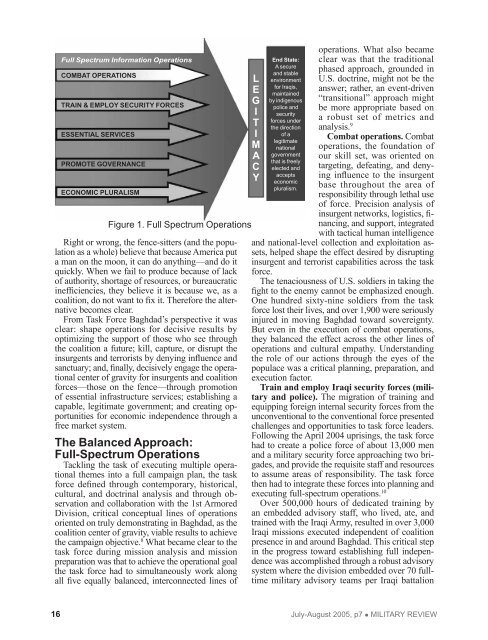Counterinsurgency Reader - Combined Arms Center - U.S. Army
Counterinsurgency Reader - Combined Arms Center - U.S. Army
Counterinsurgency Reader - Combined Arms Center - U.S. Army
You also want an ePaper? Increase the reach of your titles
YUMPU automatically turns print PDFs into web optimized ePapers that Google loves.
Full Spectrum Information Operations<br />
COMBAT OPERATIONS<br />
TRAIN & Employ security forces<br />
ESSENTIAL SERVICES<br />
PROMOTE GOVERNANCE<br />
ECONOMIC PLURALISM<br />
Figure 1. Full Spectrum Operations<br />
Right or wrong, the fence-sitters (and the population<br />
as a whole) believe that because America put<br />
a man on the moon, it can do anything—and do it<br />
quickly. When we fail to produce because of lack<br />
of authority, shortage of resources, or bureaucratic<br />
inefficiencies, they believe it is because we, as a<br />
coalition, do not want to fix it. Therefore the alternative<br />
becomes clear.<br />
From Task Force Baghdad’s perspective it was<br />
clear: shape operations for decisive results by<br />
optimizing the support of those who see through<br />
the coalition a future; kill, capture, or disrupt the<br />
insurgents and terrorists by denying influence and<br />
sanctuary; and, finally, decisively engage the operational<br />
center of gravity for insurgents and coalition<br />
forces—those on the fence—through promotion<br />
of essential infrastructure services; establishing a<br />
capable, legitimate government; and creating opportunities<br />
for economic independence through a<br />
free market system.<br />
The Balanced Approach:<br />
Full-Spectrum Operations<br />
Tackling the task of executing multiple operational<br />
themes into a full campaign plan, the task<br />
force defined through contemporary, historical,<br />
cultural, and doctrinal analysis and through observation<br />
and collaboration with the 1st Armored<br />
Division, critical conceptual lines of operations<br />
oriented on truly demonstrating in Baghdad, as the<br />
coalition center of gravity, viable results to achieve<br />
the campaign objective. 8 What became clear to the<br />
task force during mission analysis and mission<br />
preparation was that to achieve the operational goal<br />
the task force had to simultaneously work along<br />
all five equally balanced, interconnected lines of<br />
L<br />
E<br />
G<br />
I<br />
T<br />
I<br />
M<br />
A<br />
C<br />
Y<br />
End State:<br />
A secure<br />
and stable<br />
environment<br />
for Iraqis,<br />
maintained<br />
by indigenous<br />
police and<br />
security<br />
forces under<br />
the direction<br />
of a<br />
legitimate<br />
national<br />
government<br />
that is freely<br />
elected and<br />
accepts<br />
economic<br />
pluralism.<br />
operations. What also became<br />
clear was that the traditional<br />
phased approach, grounded in<br />
U.S. doctrine, might not be the<br />
answer; rather, an event-driven<br />
“transitional” approach might<br />
be more appropriate based on<br />
a robust set of metrics and<br />
analysis. 9<br />
Combat operations. Combat<br />
operations, the foundation of<br />
our skill set, was oriented on<br />
targeting, defeating, and denying<br />
influence to the insurgent<br />
base throughout the area of<br />
responsibility through lethal use<br />
of force. Precision analysis of<br />
insurgent networks, logistics, financing,<br />
and support, integrated<br />
with tactical human intelligence<br />
and national-level collection and exploitation assets,<br />
helped shape the effect desired by disrupting<br />
insurgent and terrorist capabilities across the task<br />
force.<br />
The tenaciousness of U.S. soldiers in taking the<br />
fight to the enemy cannot be emphasized enough.<br />
One hundred sixty-nine soldiers from the task<br />
force lost their lives, and over 1,900 were seriously<br />
injured in moving Baghdad toward sovereignty.<br />
But even in the execution of combat operations,<br />
they balanced the effect across the other lines of<br />
operations and cultural empathy. Understanding<br />
the role of our actions through the eyes of the<br />
populace was a critical planning, preparation, and<br />
execution factor.<br />
Train and employ Iraqi security forces (military<br />
and police). The migration of training and<br />
equipping foreign internal security forces from the<br />
unconventional to the conventional force presented<br />
challenges and opportunities to task force leaders.<br />
Following the April 2004 uprisings, the task force<br />
had to create a police force of about 13,000 men<br />
and a military security force approaching two brigades,<br />
and provide the requisite staff and resources<br />
to assume areas of responsibility. The task force<br />
then had to integrate these forces into planning and<br />
executing full-spectrum operations. 10<br />
Over 500,000 hours of dedicated training by<br />
an embedded advisory staff, who lived, ate, and<br />
trained with the Iraqi <strong>Army</strong>, resulted in over 3,000<br />
Iraqi missions executed independent of coalition<br />
presence in and around Baghdad. This critical step<br />
in the progress toward establishing full independence<br />
was accomplished through a robust advisory<br />
system where the division embedded over 70 fulltime<br />
military advisory teams per Iraqi battalion<br />
16<br />
July-August 2005, p7 • Military Review

















